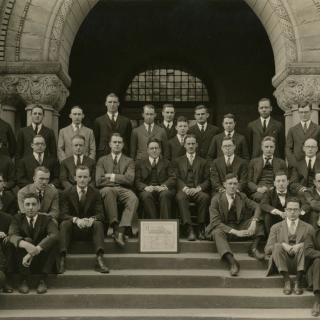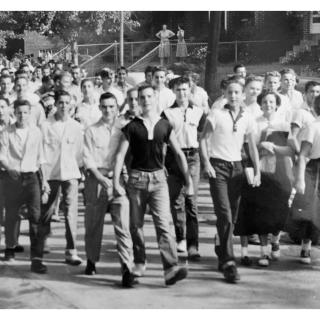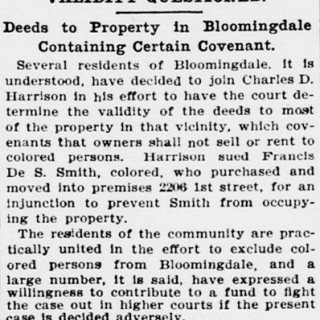Local Activists, Backed by District's Black Churches, Led the Fight for DC School Desegregation
“Do you mean that you have to travel from building to building and cross a busy street to attend classes?” Gardner Bishop, a local business owner known as the U St Barber, asked his daughter. “That’s right,” replied Judine, a 13-year-old student at Browne Junior High School, in the fall of 1947.[1] Judine’s school was chronically underfunded and overcrowded. That school year, Browne had an enrollment of around 1,600 students, more than double its capacity.[2] The reason: It was the only junior high for Black students in all of Northeast DC.[3]
Built in 1932, Browne was a relatively modern educational facility, but as a March 1947 Washington Post profile of the school described it, “in its facilities, the quality of construction, materials and in general appearance, Browne Junior High...cannot compare with the schools built for white children at this same period."[3]
To alleviate the overcrowded conditions, Judine and her classmates had been attending half-day, split schedule classes, in contrast to normal school days at most nearby white schools.[2] Notwithstanding the many other inequalities between conditions in white and Black schools, the District had tried to pass off a half school day for Black students and a full day for white students as “separate but equal.” It was a racist form of mathematics to say the least.
Now, as Judine relayed to her father, the majority-white DC Board of Education planned to use two vacant formerly white elementary schools as “annexes” for Browne students to continue their school day. However, this would require about a thousand students to commute several blocks across busy Benning Road in Northeast, to sit in classrooms that were unsupplied and built for students who were younger and smaller.[2]
The two elementary schools were wholly inadequate. They had damaged blackboards and broken window panes and lacked proper science facilities, student lockers, gymnasiums, and libraries. One school even failed to provide proper restrooms for male teachers.[4] These “annexes,” lacking in almost everything that makes a school a school, amounted to nothing more than a place to warehouse students. The policy didn’t even fix the issue of double-shifts at the junior high. Another several hundred students would continue their part-time instruction at Browne.[2]
Meanwhile, the nearby white Eliot Junior High was under capacity, and the white students enjoyed full day classes all held on one campus.[2] Like much of the country south of the Mason-Dixon line, the public schools in DC were certainly “separate” but far from “equal.”
This annex policy represented the final straw, and parents, like Bishop, were fed up. On November 29, Bishop--along with Nellie Greene, Joy Davis, and Rev. Kenneth Barnes of Jones Memorial United Methodist Church--gathered over 100 Browne parents at Jones Memorial to coordinate some of the first collective civil disobedience against segregated schools in the District.[4] Together, they formed the Browne Parent Group and, in doing so, launched a seven-year-long movement that would take them all the way to the U.S. Supreme Court.
“Such Recalcitrant Parents”
On December 3, the annex policy went into effect, and 160 parents kept their children home from school in protest of the policy. That evening, Bishop stormed into the DC Board of Education meeting to present a petition signed by the parents demanding “adequate relief” for their children.[5] As Bishop petitioned the school board, parents picketed the meeting outside, carrying signs that read “How long is temporary?” and “Our children are our jewels, give them the best education."[6]
The collective of parents vowed to keep their children out of school until the split-shift and annex policies were ended or some other arrangements were made.[5] The school officials contended with pursuing truancy charges for the parents keeping their children from attending classes--the penalty for which in 1947 was a $10 fine[7] or five days in jail[8]--but they soon decided against the measure, determining that “it would be an exercise in futility to move against such recalcitrant parents."[5] At a parent group meeting, Eulalia Matthews, a Browne parent, proclaimed, “If our children are not worth a fine or five days in jail, they might as well throw them in the [Anacostia River.]"[9]
The District’s Black churches provided crucial support for the effort from the start. Besides Jones Memorial, several other parishes served as meeting places for the activists, including Metropolitan and Shiloh Baptist Churches, and preachers at pulpits across the city called on their congregations to join in the protests as picketers.[10] Aside from physical needs such as meeting space and volunteers, the churches also provided moral and spiritual guidance in the fight. In a 1954 speech, Howard professor Margaret Just Butcher, who joined the Board of Education in 1953 and became one of the integration movement's most ardent and powerful supporters, spoke of the churches' role in the movement and "pointed particularly to the need for churches and parents to teach children basic values, to demonstrate what it means to be an American, and to take a stand that segregation is morally wrong and un-Christian."[11]
"We believe in the cause of integration, and that segregration in our schools is illegal and immoral," said Butcher, "If we follow this thesis, we can live in dignity and follow the basic Christian principles."[12]
Rev. Barnes, a Browne parent himself, reached beyond his role as a pastor to become one of the leading figures in the early days of the grassroots movement. With Nellie Greene, he represented the parent group at meetings with lawmakers on Capitol Hill[13] and in interviews with local media.[14] Barnes also opened the doors of his church to serve as the primary gathering spot for mass meetings of the Browne parents, with several hundred parents attending each event throughout December.
The boycott was highly successful throughout December 1947. By the second day of the strike, on December 4, half of the Browne student population stayed home.[15] Challenged with the question of whether it was worth it to harm their children’s educations by keeping them home, Bishop told the media, “The children may lose a half year in school, but that is not so bad as the fact that for the last 20 years the Negroes have had terrible schools. We must take the chance of the half-year loss in education."[16]
Bishop clearly saw this boycott as a long haul effort, but despite the early successes, support among Browne parents waned as the boycott dragged into 1948 with no resolution. Many sent their children back to classes at the annexes.[17] Members of the group urged Bishop to approach prominent Black attorney, Charles Houston, a former NAACP lawyer and former head of Howard University’s law school.[18]
Bishop, however, was hesitant. For much of his life, he’d held a deep distrust of upper-class, African Americans who he felt looked down upon the “little people” of the Black lower class.[19] Those feelings were hardened before the boycott when he had attempted to enroll his daughter, Judine, in a wealthy Black school but was turned away because he was a barber.[20] Bishop reflected decades after the boycott:
Segregation was not only white against black but it was also upper class black against the lower-class [black]. Don't you understand. We were on the bottom shelf. I'm black and I'm poor so I'm segregated against twice…If you didn't have the right pull your children stayed right there in the swamp.[21]
Nonetheless, Bishop appealed to Houston, and the legal giant invited Bishop and some of the other lead parents to a meeting at his home. After a long discussion of the issues of the school and the boycott, Houston announced to the activists, “You’ve got yourself a lawyer.” Houston expressed privately to a friend later on why he felt compelled to help the parents, “I have a son who will be four next month. Ever since I knew he was coming I have wrestled with the problem of remaining here and having him educated in a Jim-Crow system. I finally decided to stay and fight the system, believing that the legacy of courage and struggle will mean more."[22]
“In the Pursuit of Social Justice”
Taking on Houston as counsel marked a major shift in the strategy of the Parent Group, as his first piece of guidance was to call off the unsustainable boycott. The children returned to school in early February 1948, as the focus of the effort moved from picketing to litigation.[23] Meanwhile, signaling a shift from the localized case of Browne Junior High to a District-wide effort, the parents rebranded themselves as the “Consolidated Parent Group,” with Bishop serving as president.[24]
Houston pursued a legal strategy of equalization, urging the courts to compel the city to provide Black students an educational experience that was truly equal to that of white students. However, he stopped short of calling for full desegregation of the District schools.
With the new strategy, the Parent Group now needed a different type of support from the local community. The Black churches no longer solicited volunteers for picketing from their pulpits; they asked their congregations to chip in monetarily to help cover the Parent Group’s legal fees. Although Houston and the other lawyers worked pro bono, there were still many associated costs to finance. The churches passed around special collections at services and hosted a variety of fundraising events.[25] The Parent Group also fundraised through membership fees, bake sales,[26] and auctioning off a ham for $500.[27]
The strategy suddenly changed again in the spring of 1950. Houston died tragically after suffering a heart attack, but before he passed he appointed James Nabrit and George E. C. Hayes to take over the case. Nabrit drastically changed direction, refocusing the legal strategy from equalization to a full frontal, uncompromising assault on legalized segregation. Nabrit asked Bishop “to find students for a case against segregation per se."[28]
The idea was simple, recruit African American families who would attempt to enroll in white schools, where they would most certainly be denied and then challenge the constitutionality of the segregated policy. The NAACP was spearheading similar efforts all over the country but recruiting volunteers was easier said than done.
Just as Nabrit had taken the lead on the legal side, another figure had emerged as a leader on the spiritual and community side of the movement. Enter Reverend Samuel Everette Guiles, pastor of Campbell AME Church in Anacostia. Taking the lead among the District’s Black pastors in supporting the Parent Group, Rev. Guiles rallied the parents of Campbell AME and recruited several students from the congregation to enroll at all-white John Phillip Junior High School in Southeast.
Throughout the summer and fall of 1950, Guiles worked with Nabrit and Bishop to strategize the Parent Group’s next steps, and Campbell became a regular meeting spot for the parents.[29] James and Luberta Jennings, two Campbell congregants, signed up two of their children, Adrienne and Barbara, to be among the group of students who would take on segregation head on.
In explaining why she wanted her children to be a part of that group, Luberta Jennings cited not only the under-funded, poor conditions of the schools but also the great effort it took to get her seven children to school each day. The Afro-American reported, “She recalled cold, winter days when the buses, packed with white children from Congress Heights would pass the stop signs where her children waited. Often they had to trudge five and six miles to school in mud and snow, Mrs. Jennings said.”[30]
“My boy, who was at Armstrong, gave up the idea of being in the Cadet Corps, because he could not get to school on time. If he had been permitted to attend nearby Anacostia High, everything would have worked out fine,” Luberta said of the opportunities her children missed out on due to the dual school system.[31] Adrienne Jennings reflected years later on her parents' and the church’s role in the school desegregation effort:
The providence of God made it very clear to my parents that “change” had to come. So as leaders in their church and local community, who never accepted the status quo, it was of no surprise that my parents would be involved in the pursuit of social justice. And yes, the Campbell A.M.E. Church was right there in the center of much of the planning activities, serving as a catalyst that hosted the meetings for parental involvement in seeking social justice for young people, and, through its mere presence, reminding us of God’s existence throughout this journey of social change.[32]
On September 11, 1950, Gardner Bishop and Rev. Guiles led a group of eleven students--including several from Campbell--to John Philip Sousa Junior High, a newly built, state-of-the-art, white school.[33] When they asked to enroll, the principal of the new school refused to admit the Black students but still invited them on a tour of the modern school facilities. “Those black children walked in there and they saw the most beautiful school they had ever seen,” Bishop later recounted, “All those wonderful typewriters, the laboratories, the great gymnasium.”[34]
After appealing to the Board of Education to no avail, the Parent Group filed suit against the District school board on behalf of the eleven students. Ordered alphabetically, Spottswood Bolling, Jr. led the list of plaintiffs against the defendant, Superintendent Melvin Sharpe. In November 1950, Bolling v. Sharpe was filed in the US District Court of DC.[35]
“The Streets Were Without Dancing”
Unsurprisingly, the District Court ruled against the students in April 1951, upholding the legal segregation in the District. Nabrit and the parents quickly went to work on filing an appeal. However, before they could even appear before the Court of Appeals, Nabrit received a phone call from a clerk at the U.S. Supreme Court.[36]
Chief Justice Fred Vinson personally asked for the Bolling case to bypass the Court of Appeals and to be heard alongside the other school segregation cases appearing before the highest court. Nabrit and a small army of lawyers worked on putting together their case, while the parents continued to fundraise from the church congregations and a now nation-wide membership base.[37] By the end, the group had raised and spent over $17,000 in legal fees,[38] more than $150,000 in today’s money.
The Supreme Court heard arguments for Bolling and the other four cases that had been consolidated under Brown vs. Board of Education in December 1952, with a second round of arguments a year later. On May 17, 1954, Chief Justice Earl Warren, who had replaced Vinson after his death in 1953, delivered the court's landmark opinion: "We conclude that in the field of public education the doctrine of 'separate but equal' has no place. Separate educational facilities are inherently unequal." In the unanimous decision, the court had struck down segregation in public education nationwide, though the Bolling case had required a separate ruling due to D.C.'s unique status as a Federal enclave.
While the decision was certainly a step forward, many in the District recognized that much still had to be done to ensure the court’s ruling was carried out fully. The day after the verdict, the Washington Evening Star summed up the mood within the city’s Black communities:
It could have occasioned dancing in the streets, this decision by the highest court that elevates children with dark skin into classroom seats alongside white boys and girls. But the streets were without dancing. The death of school segregation may not be complete, but it is assured. And the death watch, at least in Washington, was hushed, rather than any noisy celebration over an enemy’s passing.[39]
Indeed, a new phase of work would begin the following September when school was back in session.
Footnotes
- ^ "D.C. group openedin case in fall of '47" Washington Afro-American, May 4, 1954.https://news.google.com/newspapers/p/afro?nid=BeIT3YV5QzEC&dat=19540504…;
- a, b, c, d, e Hardin, Daniel. “DC’s fighting barber & the end of public school segregation” Washington Area Spark. August 20, 2015. https://washingtonareaspark.com/2015/08/20/dcs-fighting-barber-the-end-…
- a, b Meyer, Agnes. “‘Modern’ Browne Junior High Far Behind White Schools” Washington Post. March 9, 1947.
- a, b McQuirter, Marya Annette. “Our Cause Is Marching On: Parent Activism, Browne Junior High School, and the Multiple Meanings of Equality in Post-War Washington.” Washington History, Vol. 16, No. 2, Commemorating the 50th Anniversary of Brown and Bolling (Fall/Winter, 2004/2005), pp. 66-82
- a, b, c McNeil, Genna Rae. "Community Initiative in the Desegregation of District of Columbia Schools, 1947-1954: A Brief Historical Overview of Consolidated Parent Group, Inc. Activities from Bishop to Bolling," Howard Law Journal 23, no. 1 (1980): 25-42
- ^ "Parents Picket in Protest of Three School Transfers: Half of Browne Pupils Out" Baltimore Afro-American. Dec. 13, 1947. https://news.google.com/newspapers/p/afro?nid=UBnQDr5gPskC&dat=19471213…;
- ^ ~$116 at 2020 currency rates
- ^ Evening star. [volume] (Washington, D.C.), 04 Dec. 1947. Chronicling America: Historic American Newspapers. Lib. of Congress. <https://chroniclingamerica.loc.gov/lccn/sn83045462/1947-12-04/ed-1/seq-…;
- ^ Evening star. [volume] (Washington, D.C.), 05 Dec. 1947. Chronicling America: Historic American Newspapers. Lib. of Congress. <https://chroniclingamerica.loc.gov/lccn/sn83045462/1947-12-05/ed-1/seq-…;
- ^ Evening star. [volume] (Washington, D.C.), 07 Dec. 1947. Chronicling America: Historic American Newspapers. Lib. of Congress. <https://chroniclingamerica.loc.gov/lccn/sn83045462/1947-12-07/ed-1/seq-…;
- ^ "Dr. Butcher Impressive: Airs Church's Role in Freedom Fight" Washington Afro-American. March 2, 1954. https://news.google.com/newspapers/p/afro?nid=BeIT3YV5QzEC&dat=19540302…
- ^ "Dr. Butcher Impressive: Airs Church's Role in Freedom Fight" Washington Afro-American. March 2, 1954. https://news.google.com/newspapers/p/afro?nid=BeIT3YV5QzEC&dat=19540302…
- ^ Evening star. [volume] (Washington, D.C.), 14 Dec. 1947. Chronicling America: Historic American Newspapers. Lib. of Congress. <https://chroniclingamerica.loc.gov/lccn/sn83045462/1947-12-14/ed-1/seq-…;
- ^ Evening star. [volume] (Washington, D.C.), 27 Dec. 1947. Chronicling America: Historic American Newspapers. Lib. of Congress. <https://chroniclingamerica.loc.gov/lccn/sn83045462/1947-12-27/ed-1/seq-…;
- ^ "Parents Picket in Protest of Three School Transfers: Half of Browne Pupils Out" Baltimore Afro-American. Dec. 13, 1947. https://news.google.com/newspapers/p/afro?nid=UBnQDr5gPskC&dat=19471213…;
- ^ "Parents Plan to Continue School Strike: All Browne Pupils to Stay Out Today, Spokesman Declares School Strike to Continue." The Washington Post (1923-1954), Jan 05, 1948. https://search-proquest-com.dclibrary.idm.oclc.org/historical-newspaper….
- ^ McQuirter, 2004
- ^ McNeil, 1980
- ^ McNeil, 1980
- ^ Hardin, 2015
- ^ Williams, Juan. "Puzzling Legacy of 1954" Washington Post, May 17, 1979. https://www.washingtonpost.com/archive/politics/1979/05/17/puzzling-leg…
- ^ Devlin, Rachel. A Girl Stands at the Door: The Generation of Young Women Who Desegregated America’s Schools. Basic Books, 2018
- ^ McNeil, 1980
- ^ McNeil, 1980
- ^ McNeil, 1980
- ^ "Recovering Untold Stories: An Enduring Legacy of the Brown v. Board of Education Decision." 2018. University of Kansas Library. http://www.npshistory.com/publications/brvb/recovering-untold-stories.p…;
- ^ McNeil, 1980
- ^ McNeil, 1980
- ^ "Recovering Untold Stories: An Enduring Legacy of the Brown v. Board of Education Decision." 2018. University of Kansas Library. http://www.npshistory.com/publications/brvb/recovering-untold-stories.p…
- ^ “DC Parent was sure of Decision” Washington Afro-American. May 18, 1954. https://news.google.com/newspapers/p/afro?nid=BeIT3YV5QzEC&dat=19540504…
- ^ “DC Parent was sure of Decision” Washington Afro-American. May 18, 1954. https://news.google.com/newspapers/p/afro?nid=BeIT3YV5QzEC&dat=19540504…
- ^ "Recovering Untold Stories: An Enduring Legacy of the Brown v. Board of Education Decision." 2018. University of Kansas Library. http://www.npshistory.com/publications/brvb/recovering-untold-stories.p…;
- ^ Hardin, 2015
- ^ Hardin, 2015
- ^ McNeil, 1980
- ^ McNeil, 1980
- ^ McNeil, 1980
- ^ Evening star. [volume] (Washington, D.C.), 18 May 1954. Chronicling America: Historic American Newspapers. Lib. of Congress. <https://chroniclingamerica.loc.gov/lccn/sn83045462/1954-05-18/ed-1/seq-…;
- ^ Evening star. [volume] (Washington, D.C.), 18 May 1954. Chronicling America: Historic American Newspapers. Lib. of Congress. <https://chroniclingamerica.loc.gov/lccn/sn83045462/1954-05-18/ed-1/seq-…;


![This integrated classroom at Anacostia High School is the culmination of a seven year struggle against DC's segregated school system. [Source: LOC] Integrated classroom at Anacostia High School](/sites/default/files/styles/embed_full_width/public/AHS%20Class_0.jpg?itok=qFy9BUjM)
![Spottswood Bolling [top right] poses with three other lead plaintiffs from the other Brown v. Board cases, including Linda Brown [bottom left], ten years after the landmark decision. [Source: LOC] Spottswood Bolling poses with three of the other lead plaintiffs in other state desegregation cases, circa 1964](/sites/default/files/styles/embed/public/Spottswood.jpg?itok=iRMR0AqS)
![Spottswood Bolling [top right] poses with three other lead plaintiffs from the other Brown v. Board cases, including Linda Brown [bottom left], ten years after the landmark decision. [Source: LOC] Spottswood Bolling poses with three of the other lead plaintiffs in other state desegregation cases, circa 1964](/sites/default/files/Spottswood.jpg)



![Sketch of the mythical fuan by Pearson Scott Foresman. [Source: Wikipedia]](/sites/default/files/styles/crop_320x320/public/2023-10/Goatman_Wikipedia_Faun_2_%28PSF%29.png?h=64a074ff&itok=C9Qh-PE1)












